Utilizing Video-Based Trainings to Improve Decision Making in High School Quarterbacks
Abstract
:1. Introduction
1.1. Working Memory
1.2. Temporal Occlusion Interventions in Sport
1.3. Current Study
- How might a temporal occlusion intervention impact high school quarterbacks’ ability to recognize defensive schemes?
- How might a temporal occlusion intervention impact the pass selection of high school quarterbacks?
- How might a temporal occlusion intervention impact the ability of high school quarterbacks, with varying levels of WMC, to adapt their tactical decisions appropriately when faced with new stimuli?
- What are high school quarterbacks’ perceptions of a perceptual training utilizing a modified temporal occlusion paradigm?
- High school quarterbacks’ ability to recognize defensive schemes will improve after completing a temporal occlusion intervention.
- High school quarterbacks’ pass selection will improve after completing a temporal occlusion intervention.
- High school quarterbacks will improve in their ability to adapt their decisions appropriately, regardless of their WMC, following the completion of a temporal occlusion intervention.
- High school quarterbacks will have positive perceptions of a perceptual training utilizing a modified temporal occlusion paradigm.
2. Materials and Methods
2.1. Participants
2.1.1. Aaron
2.1.2. Brett
2.1.3. Cam
2.1.4. Dan
2.2. Measures
2.2.1. Counting Span Task
2.2.2. Stimuli
- Time 1 (T1)—Clip began when teams broke from their huddles and ended the moment before the center began to snap the ball to the quarterback.
- Time 2 (T2)—Clip began at the moment of the snap and ended when defenders (i.e., cornerbacks) had taken their initial 2–3 steps.
- Time 3 (T3)—Clip began at the moment of the snap and ended when the quarterback had the football in hand and was looking downfield. Often, T2 and T3 clips began and ended at the same points in time.
- Time 4 (T4)—Clip began at the snap and ended the moment before the quarterback released the football.
- T1—What coverage could this be?
- T2—What coverage is this?
- T3—What route should you play? (Questions at Time 3 and Time 4 are referencing what pass the quarterback should throw based on the play-call and routes the receivers are running.)
- T4—Which option would be best now?
2.2.3. Decision-Making Test and Learning Modules
2.2.4. Social Validity Scale
2.3. Procedure
Design
2.4. Data Analysis
3. Results
3.1. Aaron
3.1.1. Overall (T1–T4)
3.1.2. Defense Recognition (T1–T2)
3.1.3. Pass Selection (T3–T4)
3.2. Brett
3.2.1. Overall (T1–T4)
3.2.2. Defense Recognition (T1–T2)
3.2.3. Pass Selection (T3–T4)
3.3. Cam
3.3.1. Overall (T1–T4)
3.3.2. Defense Recognition (T1–T2)
3.3.3. Pass Selection (T3–T4)
3.4. Dan
3.4.1. Overall (T1–T4)
3.4.2. Defense Recognition (T1–T2)
3.4.3. Pass Selection (T3–T4)
3.5. Social Validity
4. Discussion
4.1. Limitations
4.2. Implications
4.3. Conclusions
Author Contributions
Funding
Conflicts of Interest
References
- Huber, J.J. Applying Educational Psychology in Coaching Athletes; Human Kinetics: Champaign, IL, USA, 2013. [Google Scholar]
- Furley, P.A.; Memmert, D. The role of working memory in sport. Int. Rev. Sport Exerc. Psychol. 2010, 3, 171–194. [Google Scholar] [CrossRef]
- Furley, P.; Wood, G. Working memory, attentional control, and expertise in sports: A review of current literature and directions for future research. J. Appl. Res. Mem. Cogn. 2016, 5, 415–425. [Google Scholar] [CrossRef]
- Furley, P.A.; Memmert, D. Working memory capacity as controlled attention in tactical decision-Making. J. Sport Exerc. Psychol. 2012, 34, 322–344. [Google Scholar] [CrossRef] [PubMed]
- Chamberlain, C.J.; Coelho, A.J. The perceptual side of action: Decision-Making in sport. Cognitive Issues in Motor Expertise; Starkes, J.L., Allard, F., Eds.; Elsevier Science Publishers B.V.: North-Holland, The Netherlands, 1993; pp. 135–157. [Google Scholar]
- Memmert, D.; Furley, P. “I spy with my little eye!” Breadth of attention, inattentional blindness, and tactical decision making in team sports. J. Sport Exerc. Psychol. 2007, 29, 365–381. [Google Scholar] [CrossRef] [PubMed]
- Kane, M.J.; Engle, R.W. The role of prefrontal cortex in working-Memory capacity, executive attention, and general fluid intelligence: An individual-Differences perspective. Psychon. Bull. Rev. 2002, 9, 637–671. [Google Scholar] [CrossRef] [PubMed] [Green Version]
- Miller, G.A. The magical number seven, plus or minus two: Some limits on our capacity for processing information. Psychol. Rev. 1956, 63, 81–97. [Google Scholar] [CrossRef] [Green Version]
- Kane, M.J.; Conway, A.R.A.; Hambrick, D.Z.; Engle, R.W. Variation in working memory capacity as variation in executive attention and control. Variation in Working Memory; Conway, A.R.A., Jarrold, C., Kane, M.J., Miyake, A., Towse, J.N., Eds.; Oxford University Press: Oxford, UK, 2007; pp. 21–48. [Google Scholar]
- Kane, M.J.; Hambrick, D.Z.; Tuholski, S.W.; Wilhelm, O.; Payne, T.W.; Engle, R.W. The generality of working memory capacity: A latent-Variable approach to verbal and visuospatial memory span and reasoning. J. Exp. Psychol. Gen. 2004, 133, 189–217. [Google Scholar] [CrossRef]
- Baddeley, A.D. Working Memory; Issue 11 of Oxford Psychology Series; Clarendon Press: Oxford, UK, 1987. [Google Scholar]
- Baddeley, A. Working Memory, Thought, and Action; Oxford University Press: Oxford, UK, 2007. [Google Scholar]
- Norman, D.A.; Shallice, T. Attention to action: Willed and automatic control of behaviour. Consciousness and Self-Regulation: Advances in Research and Theory; Davidson, R.J., Schwarts, G.E., Shapiro, D., Eds.; Plenum: New York, NY, USA, 1986; Volume 4, pp. 1–18. [Google Scholar]
- Dicks, M.; Button, C.; Davids, K. Examination of gaze behaviors under in situ and video simulation task constraints reveals differences in information pickup for perception and action. Atten. Percept. Psychophys. 2010, 72, 706–720. [Google Scholar] [CrossRef] [Green Version]
- Owen, A.M.; Hampshire, A.; Grahn, J.A.; Stenton, R.; Dajani, S.; Burns, A.S.; Ballard, C.G. Putting brain training to the test. Nature 2010, 465, 775–779. [Google Scholar] [CrossRef] [Green Version]
- Ericsson, K.A.; Kintsch, W. Long-Term working memory. Psychol. Rev. 1995, 102, 211–245. [Google Scholar] [CrossRef]
- Farrow, D.; Abernethy, B.; Jackson, R.C. Probing expert anticipation with the temporal occlusion paradigm: Experimental investigations of some methodological issues. Motor. Control. 2005, 9, 330–349. [Google Scholar] [CrossRef] [Green Version]
- Wright, D.L.; Pleasants, F.; Gomez-Meza, M. Use of advanced visual cue sources in volleyball. J. Sport Exerc. Psychol. 1990, 12, 406–414. [Google Scholar] [CrossRef] [PubMed]
- Goulet, C.; Bard, C.; Fleury, M. Expertise differences in preparing to return a tennis serve: A visual information processing approach. J. Sport Exerc. Psychol. 1989, 11, 382–390. [Google Scholar] [CrossRef]
- McPherson, S.L. The development of sport expertise: Mapping the tactical domain. Quest 1994, 46, 223–240. [Google Scholar] [CrossRef]
- Farrow, D.; Abernethy, B. Can anticipatory skills be learned through implicit video-Based perceptual training? J. Sports Sci. 2002, 20, 471–485. [Google Scholar] [CrossRef]
- Nimmerichter, A.; Weber, N.J.R.; Wirth, K.; Haller, A. Effects of video-Based visual training on decision-making and reactive agility in adolescent football players. Sports 2016, 4, 1. [Google Scholar] [CrossRef] [Green Version]
- Murgia, M.; Sors, F.; Muroni, A.F.; Santoro, I.; Prpic, V.; Galmonte, A.; Agostini, T. Using perceptual home-Training to improve anticipation skills of soccer goalkeepers. Psychol. Sport Exerc. 2014, 15, 642–648. [Google Scholar] [CrossRef]
- Causer, J.; Smeeton, N.J.; Williams, M.A. Expertise differences in anticipatory judgements during a temporally and spatially occluded task. PLoS ONE 2017, 12, 1–12. [Google Scholar] [CrossRef] [Green Version]
- Causer, J.; Williams, A.M. The use of patterns to disguise environmental cues during an anticipatory task. J. Sport Exerc. Psychol. 2015, 37, 74–82. [Google Scholar] [CrossRef] [Green Version]
- Hopwood, M.J.; Mann, D.L.; Farrow, D.; Nielsen, T. Does visual-Perceptual training augment the fielding performance of skilled cricketers? Int. J. Sports Sci. Coach. 2011, 6, 523–535. [Google Scholar] [CrossRef]
- Müller, S.; Abernethy, B. An expertise approach to training anticipation using temporal occlusion in a natural skill setting. Technol. Instr. Cogn. Learn. 2014, 9, 295–312. [Google Scholar]
- Stone, J.A.; Maynard, I.W.; North, J.S.; Panchuk, D.; Davids, K. Temporal and spatial occlusion of advanced visual information constrains movement (re)organization in one-Handed catching behaviors. Acta Psycologicav. 2017, 174, 80–88. [Google Scholar] [CrossRef] [PubMed]
- Hagemann, N.; Strauss, B.; Cañal-Bruland, R. Training perceptual skill by orienting visual attention. J. Sport Exerc. Psychol. 2006, 28, 143–158. [Google Scholar] [CrossRef] [Green Version]
- Abernethy, B. Anticipation in squash: Differences in advance cue utilization between expert and novice players. J. Sports Sci. 1990, 8, 17–34. [Google Scholar] [CrossRef] [PubMed]
- Ward, P.; Ericsson, K.A.; Williams, A.M. Complex perceptual-cognitive expertise in a simulated task environment. J. Cogn. Eng. Decis. Mak. 2013, 7, 231–254. [Google Scholar] [CrossRef]
- Case, R.; Kurland, D.M.; Goldberg, J. Operational efficiency and the growth of short-Term memory span. J. Exp. Child. Psychol. 1982, 33, 386–404. [Google Scholar] [CrossRef]
- Engle, R.W.; Tuholski, S.W.; Laughlin, J.E.; Conway, A.R.A. Working memory, short-Term memory, and general fluid intelligence: A latent-Variable approach. J. Exp. Psychol. Gen. 1999, 128, 309–331. [Google Scholar] [CrossRef]
- Georgia Institute of Technology. Attention and Working Memory Lab. Available online: http://englelab.gatech.edu/ (accessed on 25 September 2017).
- Conway, A.R.; Kane, M.J.; Bunting, M.F.; Hambrick, D.Z.; Wilhelm, O.; Engle, R.W. Working memory span tasks: A methodological review and user’s guide. Psychon. Bull. Rev. 2005, 12, 769–786. [Google Scholar] [CrossRef]
- hudl (2016). Push Play: Performance Analysis for Sports at Every Level. Available online: https://www.hudl.com (accessed on 5 August 2017).
- McCullagh, P.; Weiss, M.R. Observational learning: The forgotten psychological method in sport psychology. In Exploring Sport and Exercise Psychology, 2nd ed.; Van Raalte, J.L., Brewer, B.W., Eds.; American Psychological Association: Washington, DC, USA, 2002; pp. 131–149. [Google Scholar]
- Psychology Software Tools. E-prime 3. 2017. Available online: https://www.pstnet.com/eprime.cfm (accessed on 3 August 2017).
- Klein, G. A recognition primed decision (RPD) model of rapid decision making. In Decision Making in Action: Models and Methods; Klein, G.A., Orasanu, J., Calderwood, R., Zsambok, C.E., Eds.; Ablex Publishing: Norwood, NJ, USA, 1993; pp. 138–147. [Google Scholar]
- Johnson, J.G.; Raab, M. Take the first: Option-Generation and resulting choices. Organ. Behav. Hum. Decis. Process. 2003, 91, 215–229. [Google Scholar] [CrossRef]
- Soto, D.; Hodsoll, J.; Rothstein, P.; Humphreys, G.W. Automatic guidance of attention from working memory. Trends Cogn. Sci. 2008, 12, 342–348. [Google Scholar] [CrossRef]
- Dulama, M.E.; Ilovan, O.R. How powerful is feedforward in university education? A case study in Romanian geography education on increasing learning efficiency. Educ. Sci. Theory Pract. 2016, 16, 827–848. [Google Scholar] [CrossRef] [Green Version]
- Horner, R.H.; Carr, E.G.; Halle, J.; McGee, G.; Odom, S.; Wolery, M. The use of single-Subject research to identify evidence-Based practice in special education. Except. Child. 2005, 71, 165–179. [Google Scholar] [CrossRef]
- Harriss, D.J.; Atkinson, G. Ethical standards in sport and exercise science research: 2014 update. Int. J. Sports Med. 2013, 34, 1025–1028. [Google Scholar] [CrossRef] [Green Version]
- Kratochwill, T.R.; Hitchcock, J.; Horner, R.H.; Levin, J.R.; Odom, S.L.; Rindskopf, D.M.; Shadish, W.R. Single-Case Designs Technical Documentation. 2010. Available online: https://ies.ed.gov/ncee/wwc/Document/229 (accessed on 8 February 2017).
- Parker, R.I.; Vannest, K.J.; Brown, L. The improvement rate difference for single-Case research. Except. Child. 2009, 75, 135–150. [Google Scholar] [CrossRef] [Green Version]
- Parker, R.I.; Vannest, K.J.; Davis, J.L. Effect size in single-Case research: A review of nine nonoverlap techniques. Behav. Modif. 2011, 35, 303–322. [Google Scholar] [CrossRef] [Green Version]
- Atkinson, R.C.; Shiffrin, R.M. Human memory: A proposed system and its control processes. The Psychology of Learning and Motivation: Advances in Research and Theory; Spence, K.W., Spence, J.T., Eds.; Academic Press: New York, NY, USA, 1968; Volume 2, pp. 89–195. [Google Scholar]
- Aiken, L.R. Three coefficients for analyzing the reliability and validity of ratings. Educ. Psychol. Meas. 1985, 45, 131–142. [Google Scholar] [CrossRef]
- Penfield, R.D.; Giacobbi, P.R., Jr. Applying a score confidence interval to Aiken’s item content-Relevance index. Meas. Phys. Educ. Exerc. Sci. 2004, 8, 213–225. [Google Scholar] [CrossRef]
- Savelsbergh, G.J.P.; Van Gastel, P.J.; Van Kampen, P.M. Anticipation of penalty kicking direction can be improved by directing attention through perceptual learning. Int. J. Sport Psychol. 2010, 41, 24–41. [Google Scholar]
- Chase, W.G.; Simon, H.A. Perception in chess. Cogn. Psychol. 1973, 4, 55–81. [Google Scholar] [CrossRef]
- Ericsson, K.A.; Krampe, R.T.; Tesch-Römer, C. The role of deliberate practice in the acquisition of expert performance. Psychol. Rev. 1993, 100, 363–406. [Google Scholar] [CrossRef]
- Abernethy, B.; Neal, R.J.; Koning, P. Visual-Perceptual and cognitive differences between expert, intermediate, and novice snooker players. Appl. Cogn. Psychol. 1994, 8, 185–211. [Google Scholar] [CrossRef]
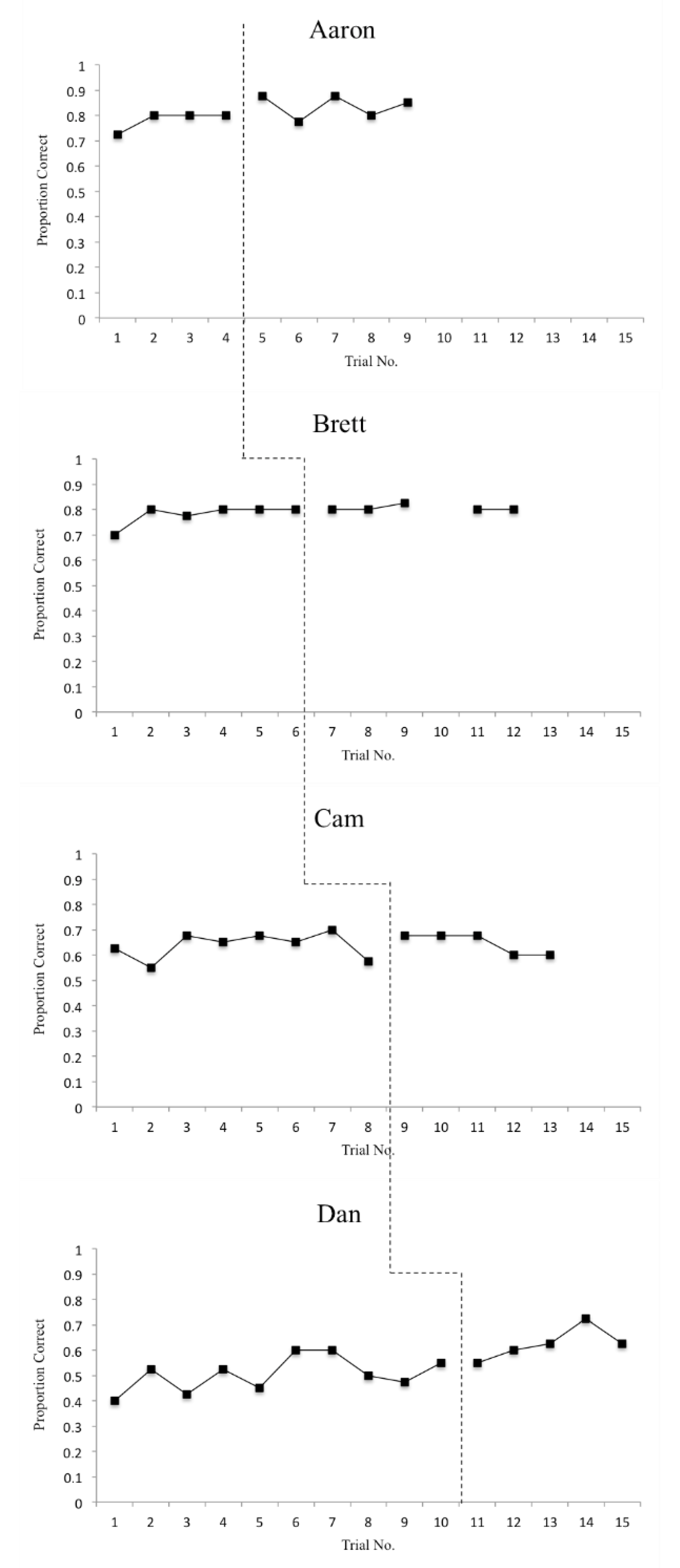
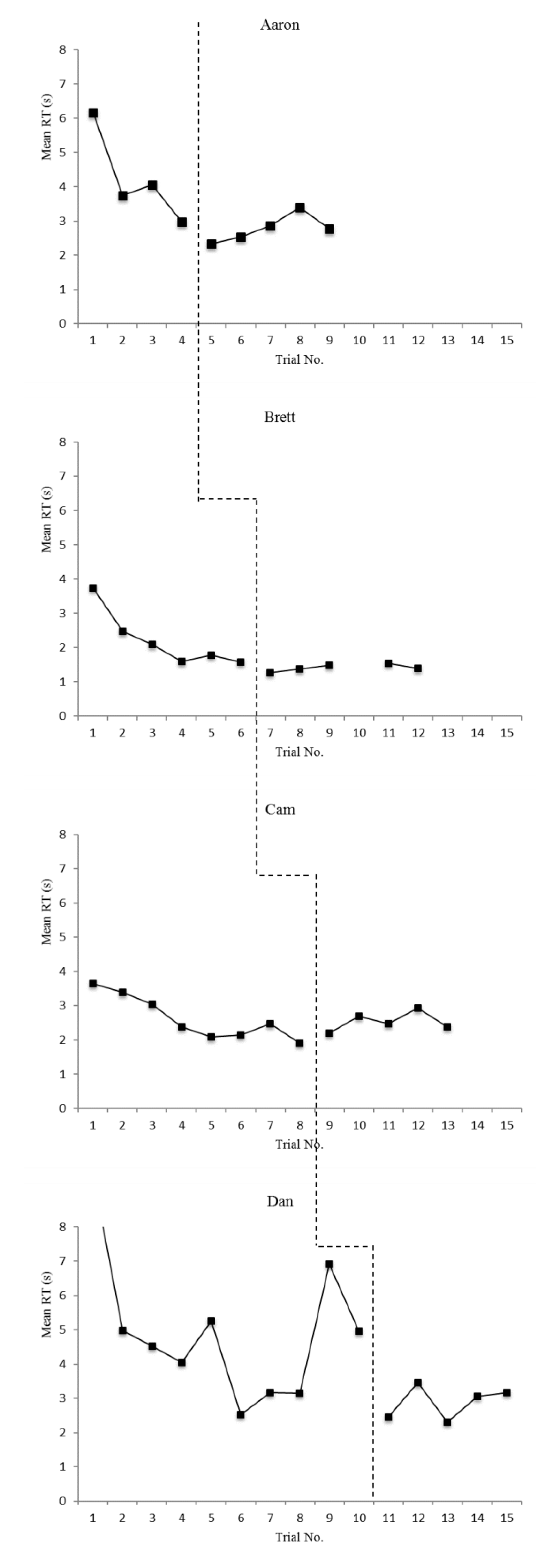
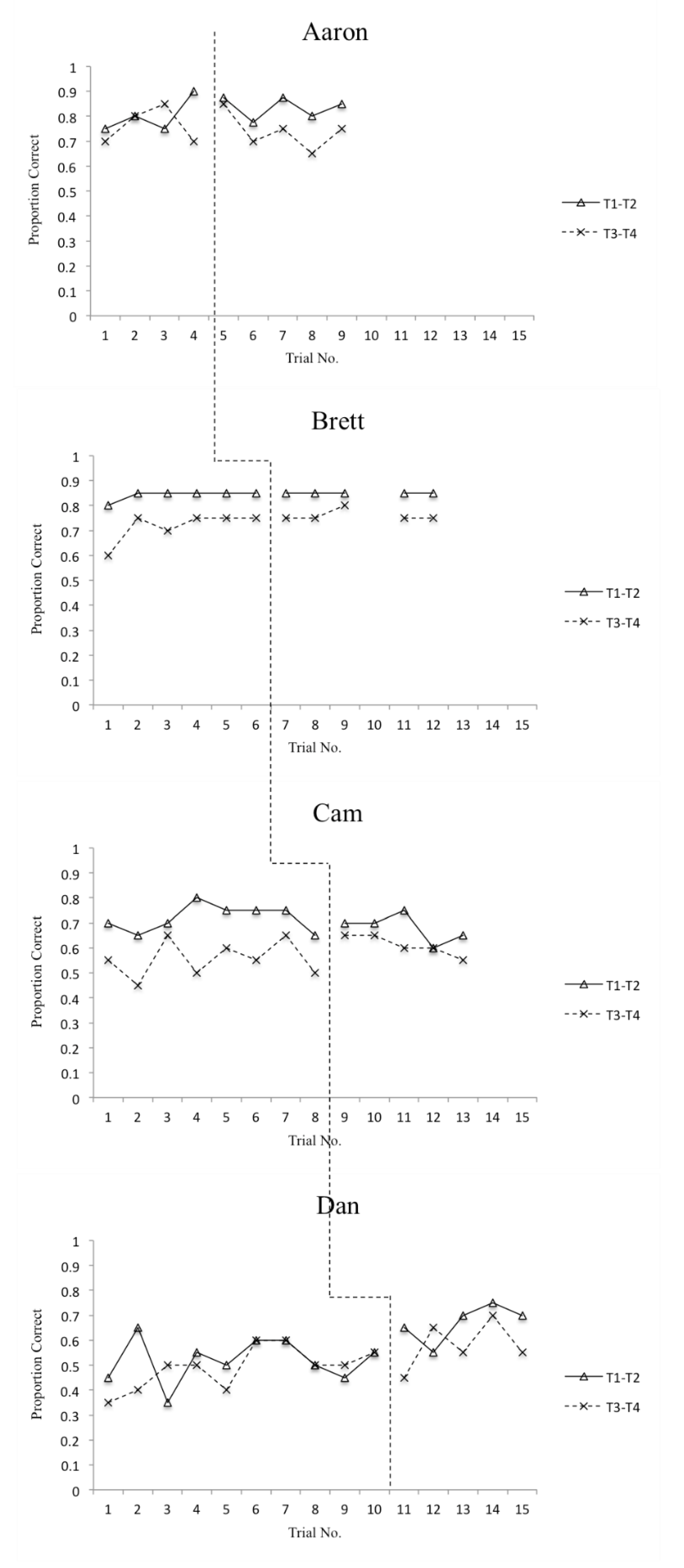
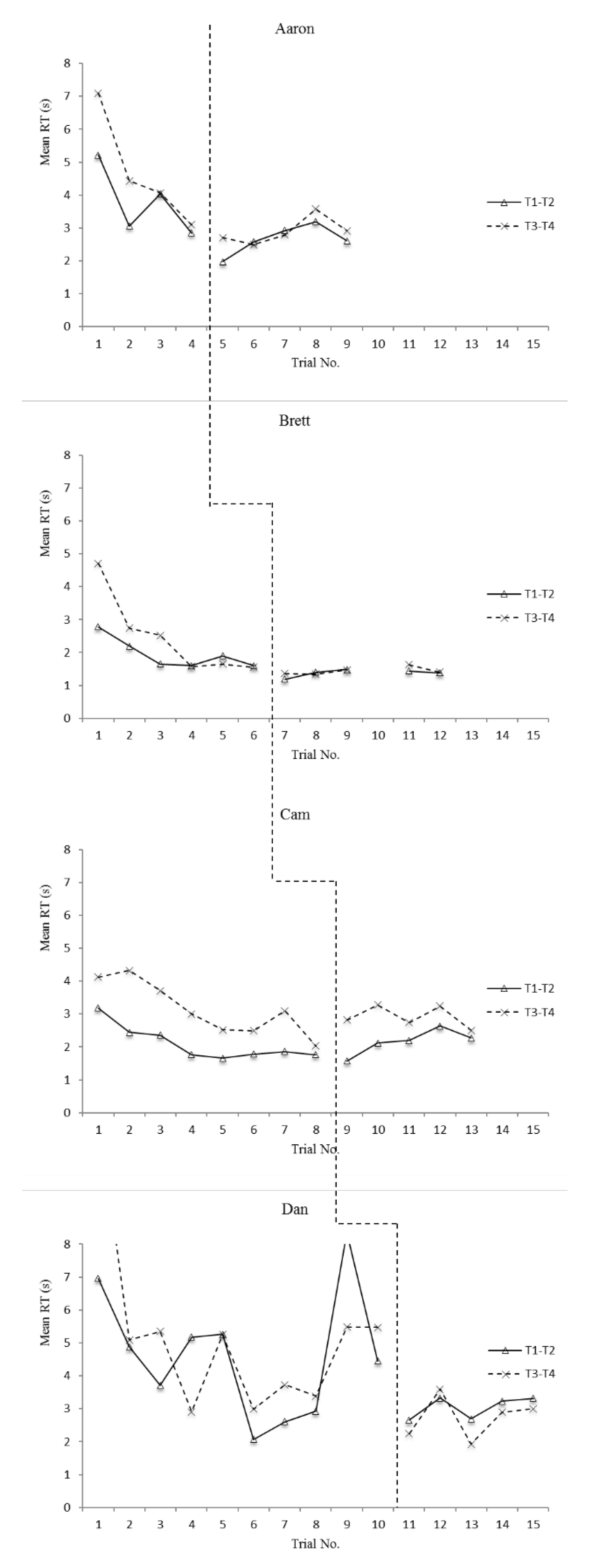
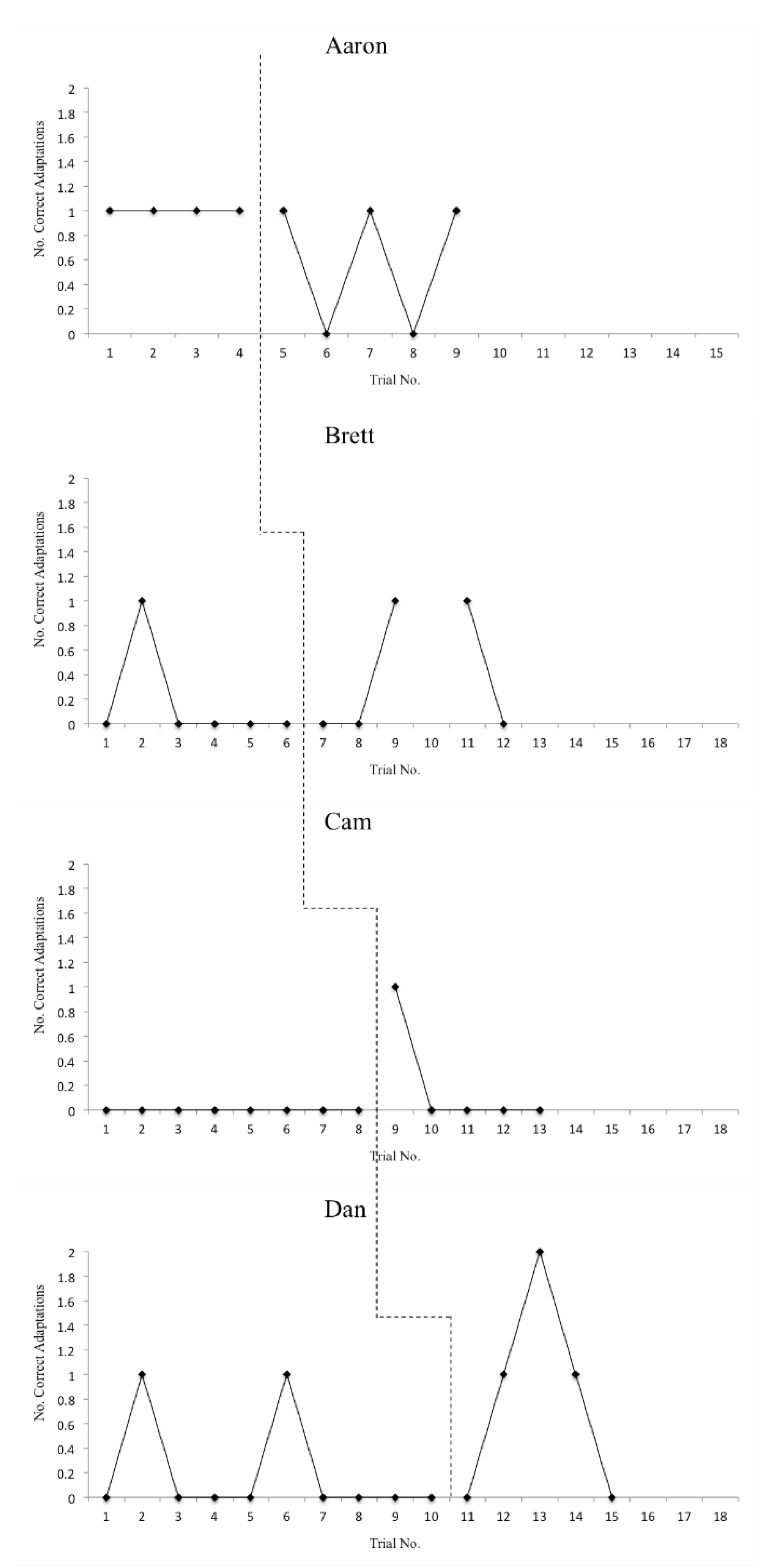
| Participant | Age | Race/Ethnicity | Class | Yrs. Playing Football | Yrs. Playing QB | Competitive Level | Hrs. Film per Week | Hrs./Wk Team Film In-Season | Hrs./Wk Team Film Out-Of-Season | Other Sports |
|---|---|---|---|---|---|---|---|---|---|---|
| Aaron | 15 | W | So. | 9 | 6 | Varsity/Junior Varsity | 3–4 | 3–4 | 0–1 | Golf |
| Brett | 17 | W | Jr. | 6 | 5 | Varsity | 12–20 | 3–4 | 1 | Baseball |
| Cam | 14 | MR | Incoming Fr. | 8 | 7 | N/A | 1 | 1 | 0 | Basketball, Baseball, Track-and-Field |
| Dan | 15 | B | Fr. | 5 | 2 | Freshman | 4–5 | 4 | 1–2 | Basketball |
| Participant | Week 1 | Week 2 | Week 3 | Week 4 | Week 5 | |||||
|---|---|---|---|---|---|---|---|---|---|---|
| Session 1 | Session 2 | Session 3 | Session 4 | Session 5 | Session 6 | Session 7 | Session 8 | Session 9 | Session 10 | |
| Aaron | B | B | I | I | I | I | I | X | X | X |
| Brett | B | B | B | I | I | I | -- | I | I | X |
| Cam | B | B | B | B | I | I | I | I | I | X |
| Dan | B | B | B | B | B | I | I | I | I | I |
| Participant | Baseline | Intervention | ||||||
|---|---|---|---|---|---|---|---|---|
| Acc | RT | Acc | RT | |||||
| M | SD | M | SD | M | SD | M | SD | |
| Aaron | 80 | 7.07 | 3.79 | 1.08 | 93 | 5.70 | 2.66 | 0.46 |
| Brett | 84.17 | 2.04 | 1.96 | 0.47 | 85 | 0 | 1.38 | 0.11 |
| Cam | 71.88 | 5.30 | 2.10 | 0.53 | 68 | 5.70 | 2.16 | 0.38 |
| Dan | 52 | 8.82 | 4.64 | 1.96 | 67 | 7.58 | 3.04 | 0.34 |
| Participant | Baseline | Intervention | ||||||
|---|---|---|---|---|---|---|---|---|
| Acc | RT | Acc | RT | |||||
| M | SD | M | SD | M | SD | M | SD | |
| Aaron | 76.25 | 7.50 | 4.67 | 1.71 | 74 | 7.42 | 2.90 | 0.41 |
| Brett | 71.67 | 6.06 | 2.46 | 1.22 | 76 | 2.24 | 1.44 | 0.12 |
| Cam | 55.63 | 7.29 | 3.16 | 0.82 | 61 | 4.18 | 2.92 | 0.33 |
| Dan | 49 | 8.43 | 5.17 | 2.65 | 58 | 9.75 | 2.73 | 0.66 |
| Participant | T1–T4 | T1–T2 | T3–T4 | Adaptation Sets | |||
|---|---|---|---|---|---|---|---|
| Acc | RT | Acc | RT | Acc | RT | Acc | |
| Aaron | 60 | 80 | 60 | 55 | −10 | 80 | −60 |
| Brett | 33.33 | 100 | 16.67 | 100 | 20 | 80 | 23.33 |
| Cam | 22.50 | 37.50 | −30 | 20 | 15 | 37.50 | 20 |
| Dan | 60 | 70 | 80 | 62.50 | 40 | 60 | 40 |
| Question | Strongly Disagree | Disagree | Agree | Strongly Agree |
|---|---|---|---|---|
| The video-based trainings have been beneficial to improving my decision making as a quarterback | -- | -- | 12.50% | 87.50% |
| I am able to keep my attention on the video-based trainings | -- | -- | 100% | -- |
| The video-based trainings interfere with my normal sport activities | 87.50% | 12.50% | -- | -- |
| The video-based trainings could cause a distraction for other players | 75% | 25% | -- | -- |
| I enjoy the video-based trainings we have done | -- | -- | 25% | 75% |
| Improving the accuracy of quarterbacks’ decision making is important | -- | -- | -- | 100% |
| Improving the speed of quarterbacks’ decision-making is important | -- | -- | -- | 100% |
| Additional Comments: | “I can really tell a difference in my decision making after these trainings and realizing the correct place to go with the ball. This really helps.” “I think it is cool and should be available to other positions.” “This helps!!” “The videos with feedback improve my decision making by a ton.” “I feel like these types of test could be helpful to other positions as well not just quarterbacks.” | |||
© 2020 by the authors. Licensee MDPI, Basel, Switzerland. This article is an open access article distributed under the terms and conditions of the Creative Commons Attribution (CC BY) license (http://creativecommons.org/licenses/by/4.0/).
Share and Cite
Powless, M.D.; Steinfeldt, J.A.; Fisher, S.E.; McFadden, P.; Kennedy, K.W.; Bellini, S. Utilizing Video-Based Trainings to Improve Decision Making in High School Quarterbacks. Sports 2020, 8, 18. https://doi.org/10.3390/sports8020018
Powless MD, Steinfeldt JA, Fisher SE, McFadden P, Kennedy KW, Bellini S. Utilizing Video-Based Trainings to Improve Decision Making in High School Quarterbacks. Sports. 2020; 8(2):18. https://doi.org/10.3390/sports8020018
Chicago/Turabian StylePowless, Matthew D., Jesse A. Steinfeldt, Shelbi E. Fisher, Patrick McFadden, Kyle W. Kennedy, and Scott Bellini. 2020. "Utilizing Video-Based Trainings to Improve Decision Making in High School Quarterbacks" Sports 8, no. 2: 18. https://doi.org/10.3390/sports8020018
APA StylePowless, M. D., Steinfeldt, J. A., Fisher, S. E., McFadden, P., Kennedy, K. W., & Bellini, S. (2020). Utilizing Video-Based Trainings to Improve Decision Making in High School Quarterbacks. Sports, 8(2), 18. https://doi.org/10.3390/sports8020018





